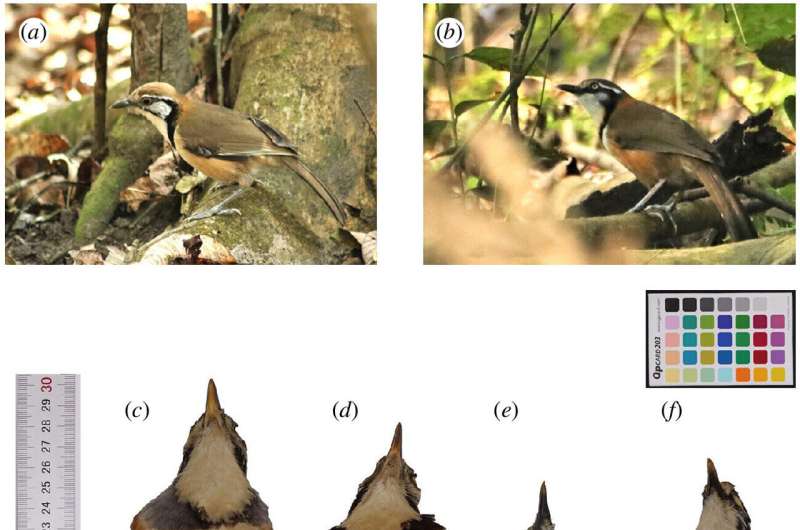April 30, 2024 report
This article has been reviewed according to Science X's editorial process and policies. Editors have highlighted the following attributes while ensuring the content's credibility:
fact-checked
peer-reviewed publication
trusted source
proofread
Mimicry allows lesser necklaced laughingthrush birds to benefit from living among larger related species

A team of ecologists, environmentalists and biologists from several institutions in China, working with a colleague from Nepal and another in the U.S., has found an instance of mimicry in a species of necklaced laughingthrush. In their study, published in the journal Royal Society Open Science, the group studied lesser and greater necklaced laughingthrush birds found both in museums and in the wild.
Necklaced laughingthrush are birds with a dark ring of feathers around the lower part of their neck, and which produce laughing-type songs. They live in many Asian countries. In this new study, the research team focused its efforts on lesser necklaced laughingthrush and their relationship with greater necklaced laughingthrush living in China and Nepal
The two species of necklaced laughingthrush look much alike—the main difference is size. They also sometimes live together, or more aptly put, the smaller, lesser variety sometimes live near or within flocks of the greater variety.
Some members of the research team noticed that when the two species live together, the lesser birds tend to look more like the greater birds than when they live apart. To find out if this was a case of mimicry, the researchers designed and carried out a study to determine whether that was the case, and which of the species was likely benefiting.
The researchers studied the coloring and patterning of multiple specimens of both species in museums and out in the field. To do so, they took photographs of each and compared them side by side. They then compared birds that lived alone with their own species versus those living together. They found changes in both color and patterning in the lesser birds when they live with the greater birds, making them look more like the larger birds. They found no such differences in the greater birds.
The findings indicate a likely instance of mimicry in the birds. They found that when the lessers lived with the greaters, the smaller birds spent less time watching for predators and more time eating. Additionally, their behavior changed slightly as they appeared to act more like the greater birds to allow them to mingle, perhaps to prevent being noticed.
More information: Kamal Raj Gosai et al, Investigating flock-associated mimicry: examining the evidence for, and drivers of, plumage mimicry in the greater and lesser necklaced laughingthrush, Royal Society Open Science (2024). DOI: 10.1098/rsos.230976
Journal information: Royal Society Open Science
© 2024 Science X Network




















